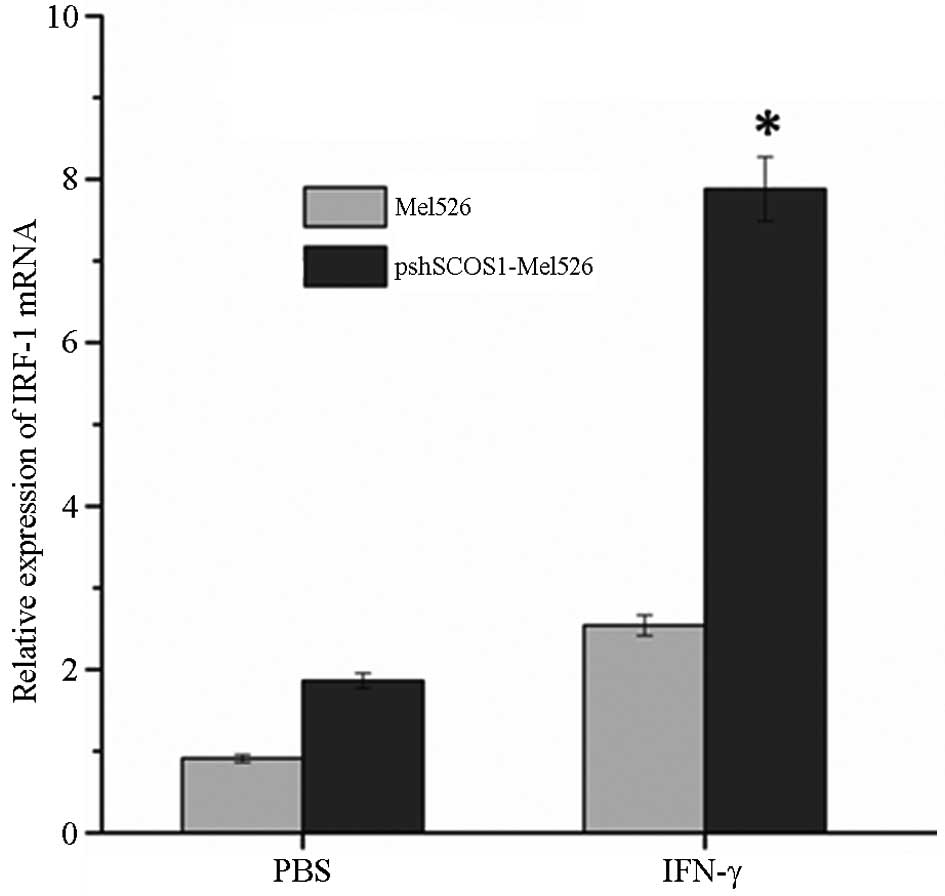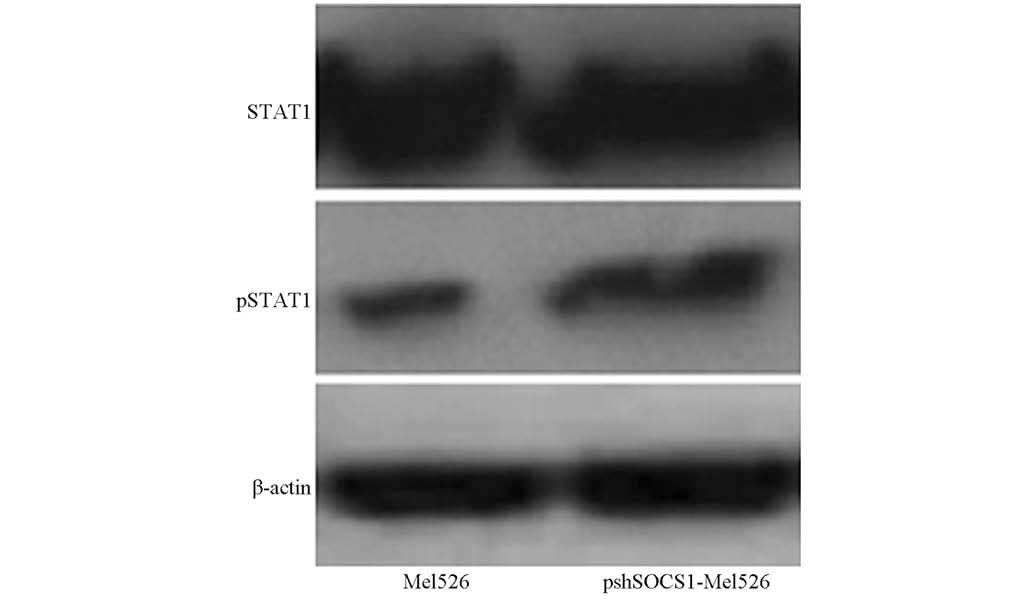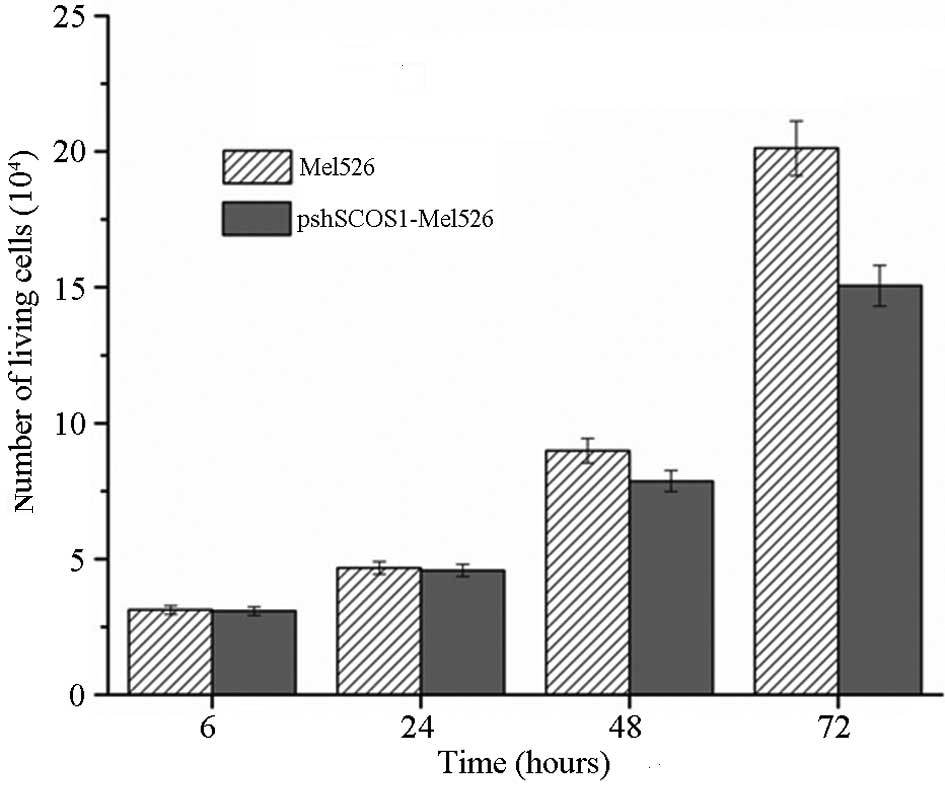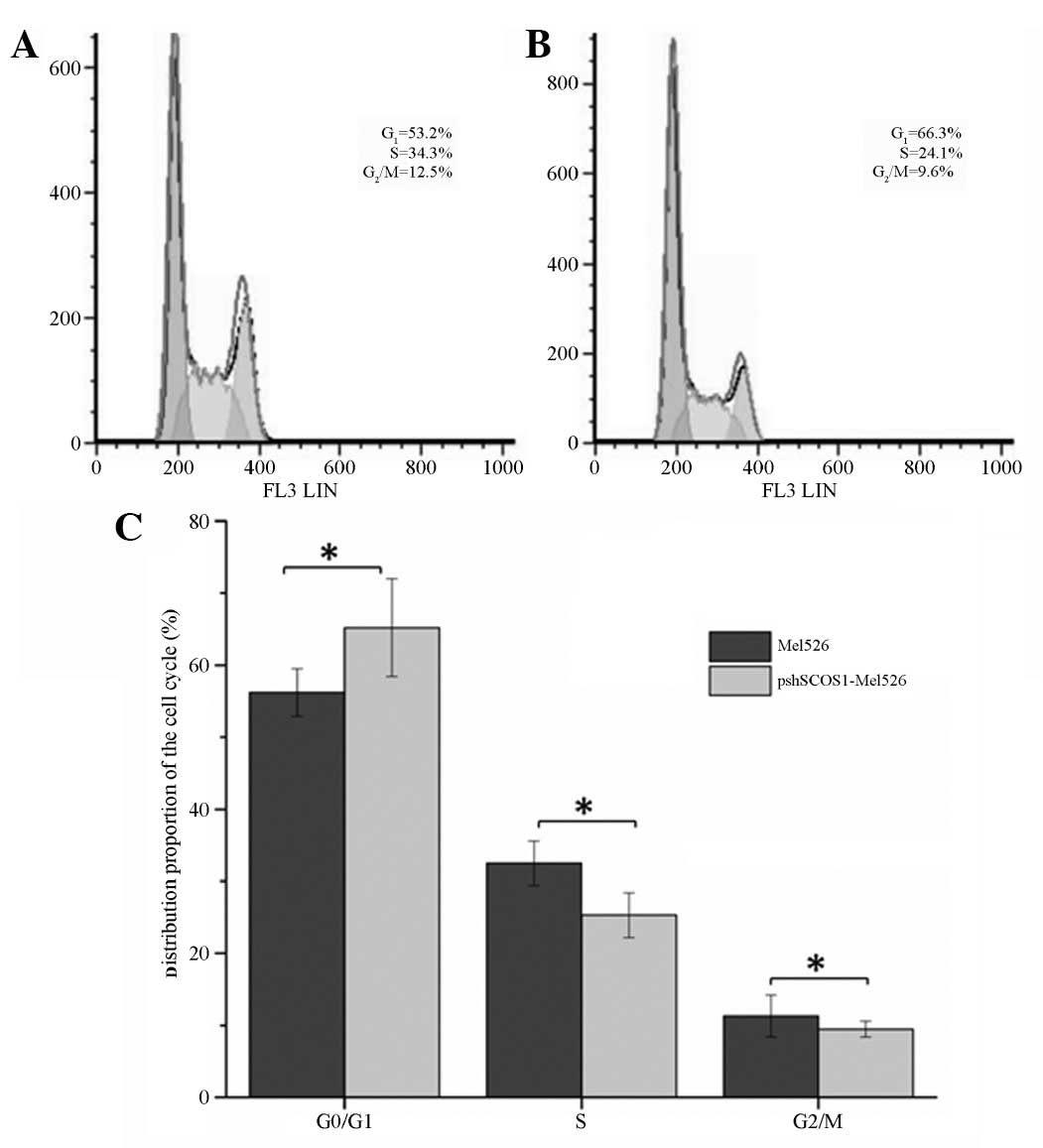Effects of suppressor of cytokine signaling 1 silencing on human melanoma cell proliferation and interferon‑γ sensitivity
- Authors:
- Published online on: October 16, 2014 https://doi.org/10.3892/mmr.2014.2674
- Pages: 583-588
Abstract
Introduction
The suppressor of cytokine signaling (SOCS) family consists of eight members, namely SOCS1-SOCS7 and CISH (cytokine-inducible SH2-containing protein). They share a central Src homology 2 domain and a highly conserved carboxy-terminal SOCS box (1). The SOCS family regulates cytokine secretion through the Janus kinase signal transduction and activators of transcription (JAK-STAT) signal transduction pathway. Although the functions of certain SOCS family members remain to be determined, CISH, SOCS1, SOCS2 and SOCS3 have been identified to negatively regulate the signal transduction of the cytokines interleukin (IL)-2, IL-4, IL-6 and interferon (IFN)-γ (2–4). It has also been observed that SOCS1 negatively regulates the JAK-STAT signal transduction pathway, the signal pathway conducted by negative feedback through the Toll-like receptor, cell differentiation and cell maturation (5). The SOCS1 gene suppresses the activity of dendritic cells (DCs), hence the silencing of the SOCS1 gene is conducive to the activation of DCs (6). In addition, SOCS1 expression has been shown to cause significant cancer cell immunity to antitumor therapies in mice (7,8), and suppressing the expression of SOCS3 has been shown to enhance the sensitivity of kidney cancer cells to IFN-α (9,10). SOCS1 serves as a target for the improvement of antigen presentation of DCs and macrophages, and it has been used in the research and development of vaccines for HIV and tumors (11,12). Furthermore, SOCS1 expression is also observed in tumor cells, and the abnormal expression of SOCS1 has been observed in a number of types of tumors, including liver cancer, melanoma and prostate cancer (13–15).
The role of SOCS1 in tumorigenesis and the development of cancer is controversial. While it has been shown that SOCS1 can inhibit the transformation of tumor cells, it has additionally been verified that SOCS1 promotes tumor cell invasion and metastasis (15). INF-γ is an important mediator in melanoma immunotherapy. Through negative feedback, SOCS1 regulates the IFN-γ signaling pathway and influences the effect of IFN-γ on cells. In order to further verify the correlation between SOCS1 and IFN-γ, the present study silenced SOCS1 in Mel526 human melanoma cells in order to investigate their sensitivity to IFN-γ.
Materials and methods
pshSOCS1 vector construction
SOCS1 interference was obtaine, according to the previous study (16). The synthesized small hairpin RNA oligonucleotide sequence (primer design and synthesis undertaken by Shanghai Sangon Inc., Shanghai, China) was annealed to form a double stranded DNA fragment and cloned into an ENTR/U6 vector (Invitrogen Life Technologies, Carlsbad, CA, USA), thereby generating the pshSOCS1 vector. A BLOCK-iT™ U6 RNAi Entry Vector kit was purchased from Invitrogen Life Technologies, a 2X Taq PCR MasterMix PCR Amplification kit was purchased from Tiangen Inc. (Beijing, China) and the PCR Amplifier used was the Gene Amp PCR system 9600 (PerkinElmer, New York, USA).
Cell culture and transfection
Mel-526 human melanoma cells (American Type Culture Collection, Manassas, VA, USA) were routinely cultured in Dulbecco’s modified Eagle’s medium (DMEM) containing 10% fetal calf serum (Hangzhou Sijiqing Biological Engineering Materials Co., Ltd, Hangzhou, China). The solution was placed in an incubator with 5% CO2 and saturated humidity at 37°C. Every 3–4 days, one passage was conducted. Cells at the logarithmic phase were selected and inoculated with a concentration of ~3×106 cells/well for each experiment. One day prior to transfection, cells were plated in a 6-pore plate. Four hours after the transfection, the medium was replaced and then transferred to a medium with blood serum for culturing and further collection for analysis. Lipofectamine 2000 (Invitrogen Life Technologies) was used for cell transfection according to the manufacturer’s instructions and 48 h later the cells were stimulated with IFN-γ (Peprotech, Princeton, NJ, USA) for 4 h.
Reverse transcription-quantitative polymerase chain reaction (RT-qPCR)
The transfected cells and normal cells were collected 48 h posttransfection. TRIzol® (Invitrogen Life Technologies) was used to extract the total RNA from the cells. M-MLV reverse transcriptase (Huicheng Biotechnology Co., Ltd., Shanghai, China) was used to produce cDNA. With the cDNA in each group as the template, a buffer primer solution was added for PCR. The process was repeated for each sample three times. GAPDH was used as an internal reference. The primers used were as follows: Forward: 5′-ATGCAGTCTCCACAGCAGCAGAG-3′ and reverse: 5′-CGAACGGAATGTGCGGAAGTG-3′ for SOCS1; forward: 5′-TCTTCCCTCTTCCACTCGGAGTCG-3′ and reverse: 5′-CTTCTGACCCATGCCCACCA-3′ for IRF-1; and forward: 5′-GAAGGTGAAGGTCGGAGTC-3′ and reverse: 5′-GAAGATGGTGATGGGATTTC-3′ for GAPDH. The volume of the reaction system was 50 μl and the reaction conditions were as follows: 5 min of pre-degeneration at 95°C followed by 40 cycles of 30 sec at 94°C, 30 sec of annealing (SOCS1, 60°C; IRF-1, 56°C; GAPDH, 55°C), 1 min at 72°C, and finishing with 7 min of annealing at 72°C. At the end of the PCR, the loading buffer was added. The product was processed by 1.5% agarose gel electrophoresis. The bands were observed using the gel-imaging system (Bio-Rad, Hercules, CA, USA). The PCR kit used was a Real-Time PCR kit purchased from Takara Bio, Inc. (Dalian, China).
Western blot analysis
Transfected and normal cells were collected 48 h post-transfection. Cells were washed twice with cold phosphate-buffered saline (PBS), cell lysis buffer was added (25 mmol/l Tris-HCl, 10 mmol/l EDTA, a volume fraction of 0.01 NP-40, 150 mmol/l sodium chloride and 1 g/l phenylmethylsulfonyl fluoride), and the solution was placed in an ice bath for 1 h. The solution was centrifuged at 4°C and 16,000 g for 25 min. The protein concentration of the supernatant was measured by the Lowry method (17). Cell lysates (50 μg) were extracted and electro-transferred to a polyvinylidene fluoride (PVDF) membrane by SDS-PAGE gel electrophoresis. Skimmed milk powder with the mass fraction of 0.05 was used to block the PVDF membrane for 1 h, and STAT1 rabbit monoclonal (Abcam, London, UK), p-STAT1 mouse monoclonal (Abcam, London, UK), SOCS-1 rabbit anti-human (Millipore, Billerica, MA, USA) and β-actin rabbit anti-human (ORI Gene, Beijing, China) monoclonal antibodies were added to the solution and incubated at 4°C overnight. The membranes were washed and goat anti-mouse or anti-rabbit antibodies labeled with horseradish peroxidase (diluted at 1:5,000; ORI Gene, Beijing, China) were added and the reaction was left for 2 h. The PVDF membrane was cleaned, an Enhanced Chemiluminescence reagent was added and the membrane was placed in an X-ray cassette, tableted, developed in a dark room and finally fixed. A GDS8000 image acquisition and analysis system (UVP Inc., Upland, CA, USA) was used for image capture and quantitative analysis of the western blots.
MTT assay
One day prior to the experiment, cells at logarithmic phases were divided into 96-pore plates at a density of 1.0×104 cells/pore. INF-γ and fluorouracil were added at different concentrations. The INFγ and fluorouracil were prepared with dimethyl sulfoxide (DMSO) or PBS to produce 10 mmol/l stock solutions, and the working concentrations used were 0.625, 1.25, 2.5, 5.0, 10.0 and 20.0 μmol/l. A total of six multiple pores were set up with each concentration to reduce deviation of the data and improve accuracy. Following a 48-h culture, 4.5 g/l MTT solution was added and the solution was cultured for 5 h at 37°C. The supernatant was then discarded and 160 μl DMSO was added to each pore. Subsequently, the light absorption values were measured at a wavelength of 550 nm. Prism software v.4.0 (Graphpad Software, La Jolla, CA, USA) was used to calculate the median inhibitory concentration (IC50). The experiments were repeated three times.
Cell proliferation
Cells were seeded into a 96-pore plate at a density of 3×104 cells/well, and three multiple pores were set up for each time point to reduce deviation of the data and improve accuracy. Cells were collected 6, 24, 48 and 72 h following the transfection, the isopyknic living cell number was counted and the rate of cell proliferation was calculated according to the number of isopyknic living cells.
Cell cycle detection
Cells in the supernatant and the adherent cells were collected 48 post-transfection, rinsed twice with PBS and the solution was fixed for 24 h at 4°C using cold ethyl alcohol with a volume fraction of 0.70. Subsequently, the cells were washed twice with PBS and stained in the absence of light with propidium iodide at 4°C for 30 min. A FACsort flow cytometer (BD Biosciences, Franklin Lakes, NJ, USA) was used for the cell cycle analysis.
Statistical analysis
SPSS version 16.0 statistical software (SPSS Inc., Chicago, IL, USA) was used for statistical analysis. Data are expressed as the mean ± standard deviation, and the mean comparison was conducted with a t-test. P<0.05 was considered to indicate a statistically significant difference.
Results
Verification of SOCS1 interference effects
SOCS1 was effectively silenced in transfected cells compared with that in the non-transfected cells (Fig. 1). The qPCR results showed that SOCS1 expression was silenced by 90%.
SOCS1 silencing significantly increases the expression levels of IRF-1
SOCS1 efficiently regulates the signal transduction pathway of cytokines via negative feedback. Analysis of the impact of SOCS1 expression on the IFN-γ sensitivity of cells may aid in predicting the lethal effects of IFN-γ on cells. Transfected Mel526 cells were subjected to 6 h of IFN-γ or isometric PBS stimulation 48-h post-transfection. The cells were collected for RT-qPCR analysis to observe changes in the expression levels of nuclear transcription factor IRF-1 following the activation of IFN-γ. Compared with non-transfected cells SOCS1 silencing significantly increased the expression levels of IRF-1 (P<0.05; Fig. 2). Subsequently, cells were gathered for STAT1 and pSTAT1 detection. It was found that pSTAT1 expression was greatly increased in the transfected cells (Fig. 3).
INF-γ sensitivity of cells improved following SCOS1 silencing
The IC50 of chemotherapeutics INF-γ and fluorouracil to Mel526 cells was detected with an MTT assay. Compared with the null vector transfection group, the IC50 of INF-γ and fluorouracil in Mel526 cells in the transfection group was marginally reduced. There was no significant difference between the IC50 of fluorouracil in the Mel526 cells prior to and following SCOS1 silencing (P>0.05). However, there was a significant difference between the IC50 of INF-γ in Mel526 cells prior to and following SCOS1 silencing (P<0.05, Table I). This indicates that after the reduction in the expression levels of SCOS1, the sensitivity of Mel526 cells to INF-γ was greatly improved.
Cell proliferation
The number of cells 24 h following transfection was not markedly changed. The number of Mel-526 cells after 48 h exceeded that in the transfection group. The difference was clearer after 72 h (Fig. 4).
SOCS1 silencing alters the cell cycle composition
Compared with the control group, following SCOS1 silencing, the ratio of cells in the G0/G1 phase significantly increased (P<0.05), but those in the S and G2/M phases were significantly reduced (P<0.05; Fig. 5). The results demonstrated that SCOS1 silencing caused cell cycle arrest in the G0/G1 phase.
Discussion
SOCS1 serves as an inhibitory molecule in a number of types of tumors, including liver cancer (13), prostate cancer (15) and head and neck neoplasms (18). In tumor cells, SOCS1 expressions levels have been shown to be reduced by certain mechanisms, including the methylation of the promoter region (19), and SOCS1 was found to be methylated in 60% of liver cancers (13). Following the over-expression of SOCS1 in modified tumor cells, cell apoptosis may be induced, thus inhibiting the tumor cell proliferation. The reduction in expression levels of SOCS1 also weakened its regulation of the JAK/STAT signaling pathway through negative feedback, increasing the sensitivity of cells to a range of inflammatory molecules and allowing other mechanisms to induce the transformation of cells and generate tumors. The SOCS1 expression level has been shown to negatively correlate with the degree of tumor infiltration (15,20,21); however, the results of studies on the role of SOCS1 in tumorigenesis of hormone-dependent malignancies were inconsistent. In breast cancer, methylation was found to reduce the expression level of SOCS1, and the overexpression can increase the SOCS1 expression and result in tumor suppression (22). However, certain studies have proposed that the expression levels of SOCS1 in breast cancer were higher than in healthy mammary tissues, but that in the breast cancer cell line the expression did not rise. The high expression levels of SOCS1 in tumor tissues may be caused by the stimulation of inflammation stroma, such as GH growth hormone and prolactin (23).
Among prostate cancer patients receiving castration, the expression levels of SOCS1 were reduced. However, in patients with recurring prostate cancer, the expression levels of SOCS1 were increased, indicating that androgens may stimulate the expression of SOCS1. This was verified by in vitro experiments (24). Additionally, it has been found that SOCS1 could lower the expression levels of cyclin and cyclin-dependent kinase and inhibit cell growth. Among the different types of melanoma, 75% were shown to have SOCS1 methylation (14). Furthermore, the levels of SOCS1 expression in melanoma transfer sites was reduced. An in vitro study found that overexpression of SOCS1 in cells inhibited cell proliferation and metastasis (22). However, other studies identified that compared with healthy melanophores, higher levels of SOCS1 expression were correlated with tumor metastasis and invasion. Hence, SOCS1 expression may be a biomarker to predict tumorigenesis and development (25). Additionally, high expression levels of SOCS1 may influence the sensitivity of cells to diverse cytokines, for example IFN-γ. For SOCS1-knockout mice, IFN-α enhanced their antineoplastic activity through the action of CD4 and CD8 T cells (26). Induction of SOCS1 expression enables the human T-lymphocytic leukemia virus type 1 to avoid the antiviral activity of type I IFN (27). In addition, SOCS1 eliminates the inhibitory effects of type I IFN on hepatitis C virus replication (28). miR-122 adjusts the level of type I IFN expression by blocking SOCS1 (29).
IFN-γ is an important cytokine in melanoma immunotherapy, which regulates cell differentiation, proliferation and other functions through the JAK/STAT signaling pathway. SOCS1 is a key negative regulator of the JAK/STAT signaling pathway and may have a vital role in the reduction of IFN-γ sensitivity. Clinically, a number of patients undergoing IFN-γ treatment show IFN-γ resistance or insensitivity, which further limits the use of IFN-γ and reduces its efficacy as a melanoma treatment. Thus, silencing SOCS1 expression in cells to improve the sensitivity of cells to IFN-γ may be important for the treatment of melanoma. In the current study, with Mel526 cells as the experimental model, it was found that silencing SOCS1 can improve IFN-γ sensitivity, thus providing a novel approach to improve the efficacy of melanoma immunotherapy. However, for different types of melanoma as the experimental models, the experimental results can differ (30). Thus, a number of factors should be integrated in the clinical translational research, including pathological features and hormone-dependency.
The experimental results of the present study showed that following the silencing of SOCS1 expression in Mel526 cells, IFN-γ stimulation increased the levels of pSTAT1 expression, i.e. the IFN-γ signaling pathway was enhanced. Thereby, it can increase the expression of target genes and influence the growth of tumor cells. In addition, IRF-1 expression was increased. The aforementioned findings demonstrate that following silencing of SOCS1, the sensitivity of cells to IFN-γ was enhanced. Furthermore, it was found that silencing SOCS1 expression in Mel526 cells could influence the cell cycle. During SOCS1 silencing, the S phase of the cell cycle was extended. In other words, the replication time of genetic material of cells was prolonged, which may inhibit the proliferative ability of cells. The measurement of the cell proliferation rate verified this phenomenon.
Enhancing the sensitivity of cells to IFN-γ is an important approach in the treatment of melanoma. The results of the current study showed that silencing SOCS1 expression in Mel526 cells significantly enhanced the cell sensitivity to IFN-γ and influenced the cell cycle, leading to a prolonged S phase and inhibition of the proliferation of tumor cells. These results indicate that SOCS1 may be a vital target that influences therapeutic effects of melanoma.
References
|
Linossi EM, Babon JJ, Hilton DJ and Nicholson SE: Suppression of cytokine signaling: the SOCS perspective. Cytokine Growth Factor Rev. 24:241–248. 2013. View Article : Google Scholar : PubMed/NCBI | |
|
Shi J and Wei L: Regulation of JAK/STAT signalling by SOCS in the myocardium. Cardiovasc Res. 96:345–347. 2012. View Article : Google Scholar : PubMed/NCBI | |
|
Tamiya T, Kashiwagi I, Takahashi R, Yasukawa H and Yoshimura A: Suppressors of cytokine signaling (SOCS) proteins and JAK/STAT pathways: regulation of T-cell inflammation by SOCS1 and SOCS3. Arterioscler Thromb Vasc Biol. 31:980–985. 2011. View Article : Google Scholar : PubMed/NCBI | |
|
Yoshimura A, Suzuki M, Sakaguchi R, Hanada T and Yasukawa H: SOCS, inflammation, and autoimmunity. Front Immunol. 3:202012. View Article : Google Scholar | |
|
Bhattacharyya S, Zhao Y, Kay TW and Muglia LJ: Glucocorticoids target suppressor of cytokine signaling 1 (SOCS1) and type 1 interferons to regulate Toll-like receptor-induced STAT1 activation. Proc Natl Acad Sci USA. 108:9554–9559. 2011. View Article : Google Scholar : PubMed/NCBI | |
|
Satou R, Miyata K, Gonzalez-Villalobos RA, Ingelfinger JR, Navar LG and Kobori H: Interferon-γ biphasically regulates angiotensinogen expression via a JAK-STAT pathway and suppressor of cytokine signaling 1 (SOCS1) in renal proximal tubular cells. FASEB J. 26:1821–1830. 2012. | |
|
Hong B, Ren W, Song XT, Evel-Kabler K, Chen SY and Huang XF: Human SOCS1 controls immuno-stimulatory activity of monocyte derived dendritic cells. Cancer Res. 69:8076–8084. 2009. View Article : Google Scholar : PubMed/NCBI | |
|
Hu Q, Qin X, Qian G, et al: SOCS1 silencing can break high-dose dendritic cell immuno therapy induced immune tolerance. Mol Med Report. 1:61–70. 2008.PubMed/NCBI | |
|
Ortiz-Muñoz G, Martin-Ventura JL, Hernandez-Vargas P, et al: Suppressors of cytokine signaling modulate JAK/STAT mediated cell responses during atherosclerosis. Arterioscler Thromb Vasc Biol. 29:525–531. 2009.PubMed/NCBI | |
|
Tomita S, Ishibashi K, Hashimoto K, et al: Suppression of SOCS3 increases susceptibility of renal cell carcinoma to interferon-α. Cancer Sci. 102:57–63. 2011.PubMed/NCBI | |
|
Evel-Kabler K, Song XT, Aldrich M, Huang XF and Chen SY: SOCS1 restricts dendritic cells’ ability to break self tolerance and induce antitumor immunity by regulating IL-12 production and signaling. J Clin Inves. 116:90–100. 2006. | |
|
Song XT, Evel-Kabler K, Rollins L, Aldrich M, Gao F, Huang XF and Chen SY: An alternative and effective HIV vaccination approach based on inhibition of antigen presentation attenuators in dendritic cells. PLoS Med. 3:e112006. View Article : Google Scholar : PubMed/NCBI | |
|
Chu PY, Yeh CM, Hsu NC, Chang YS, Chang JG and Yeh KT: Epigenetic alteration of the SOCS1 gene in hepatocellular carcinoma. Swiss Med Wkly. 140:w130652010.PubMed/NCBI | |
|
Liu S, Ren S, Howell P, Fodstad O and Riker AI: Identification of novel epigenetically modified genes in human melanoma via promoter methylation gene profiling. Pigment Cell Melanoma Res. 21:545–558. 2008. View Article : Google Scholar : PubMed/NCBI | |
|
Neuwirt H, Puhr M, Santer FR, et al: Suppressor of cytokine signaling (SOCS)-1 is expressed in human prostate cancer and exerts growth-inhibitory function through down-regulation of cyclins and cyclin-dependent kinases. Am J Pathol. 174:1921–1930. 2009. View Article : Google Scholar | |
|
Lesinski GB, Zimmerer JM, Kreiner M, et al: Modulation of SOCS protein expression influences the interferon responsiveness of human melanoma cells. BMC Cancer. 10:1422010. View Article : Google Scholar : PubMed/NCBI | |
|
Kusunoki H, Okuma K and Hamaguchi I: Estimation of lactose interference in vaccines and a proposal of methodological adjustment of total protein determination by the lowry method. Jpn J Infect Dis. 65:489–494. 2012. View Article : Google Scholar : PubMed/NCBI | |
|
Starska K, Forma E, Lewy-Trenda I, Stasikowska O, Bryś M, Krajewska WM and Łukomski M: The expression of SOCS1 and TLR4-NFkappaB pathway molecules in neoplastic cells as potential biomarker for the aggressive tumor phenotype in laryngeal carcinoma. Folia Histochem Cytobiol. 47:401–410. 2009. | |
|
Ko E, Kim SJ, Joh JW, Park CK, Park J and Kim DH: CpG island hypermethylation of SOCS-1 gene is inversely associated with HBV infection in hepatocellular carcinoma. Cancer Lett. 271:240–250. 2008. View Article : Google Scholar : PubMed/NCBI | |
|
Cooper JC, Shi M, Chueh FY, Venkitachalam S and Yu CL: Enforced SOCS1 and SOCS3 expression attenuates Lck-mediated cellular transformation. Int J Oncol. 36:1201–1208. 2010.PubMed/NCBI | |
|
Huang FJ, Steeg PS, Price JE, et al: Molecular basis for the critical role of suppressor of cytokine signaling-1 in melanoma brain metastasis. Cancer Res. 68:9634–9642. 2008. View Article : Google Scholar : PubMed/NCBI | |
|
Sutherland KD, Lindeman GJ, Choong DY, et al: Differential hypermethylation of SOCS genes in ovarian and breast carcinomas. Oncogene. 23:7726–7733. 2004. View Article : Google Scholar : PubMed/NCBI | |
|
Sasi W, Jiang WG, Sharma A and Mokbel K: Higher expression levels of SOCS 1,3,4,7 are associated with earlier tumour stage and better clinical outcome in human breast cancer. BMC Cancer. 10:1782010. View Article : Google Scholar : PubMed/NCBI | |
|
Neuwirt H, Puhr M, Santer FR, et al: Suppressor of cytokine signaling (SOCS)-1 is expressed in human prostate cancer and exerts growth-inhibitory function through down-regulation of cyclins and cyclin-dependent kinases. Am J Pathol. 174:1921–1930. 2009. View Article : Google Scholar : PubMed/NCBI | |
|
Scutti JA, Matsuo AL, Pereira FV, et al: Role of SOCS-1 gene on melanoma cell growth and tumor development. Transl Oncol. 4:101–109. 2011. View Article : Google Scholar : PubMed/NCBI | |
|
Guenterberg KD, Lesinski GB, Mundy-Bosse BL, Karpa VI, Jaime-Ramirez AC, Wei L and Carson WE III: Enhanced anti-tumor activity of interferon-alpha in SOCS1-deficient mice is mediated by CD4- and CD8- T cells. Cancer Immunol Immunother. 60:1281–1288. 2011. View Article : Google Scholar : PubMed/NCBI | |
|
Olière S, Hernandez E, Lézin A, et al: HTLV-1 evades type I interferon antiviral signaling by inducing the suppressor of cytokine signaling 1 (SOCS1). PLoS Pathog. 6:e10011772010.PubMed/NCBI | |
|
Shao RX, Zhang L, Hong Z, et al: SOCS1 abrogates IFN’s antiviral effect on hepatitis C virus replication. Antiviral Res. 97:101–107. 2013. | |
|
Li A, Song W, Qian J, et al: MiR-122 modulates type I interferon expression through blocking suppressor of cytokine signaling 1. Int J Biochem Cell Biol. 45:858–865. 2013. View Article : Google Scholar : PubMed/NCBI | |
|
Mathieu MG, Miles AK, Ahmad M, et al: The helicase HAGE prevents interferon-α-induced PML expression in ABCB5+ malignant melanoma-initiating cells by promoting the expression of SOCS1. Cell Death Dis. 5:e10612014.PubMed/NCBI |














